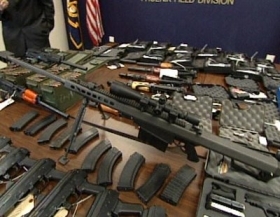A recently captured Zetas leader has claimed that the group obtains all of its arms from the United States, but while the announcement is sure to fuel the debate over gun control in the U.S., the group is believed to receive a significant chunk of its armory from other countries in the region.
During an interview recorded by Mexico’s Ministry of Public Safety, Jesus Enrique Rejon, alias ‘El Mamito’ told officials that the feared drug gang purchases all of its guns in the U.S. In the interview (the video of which is embedded below) Rejon claims the group used to sneak the arms through border checkpoints, but stricter security measures have forced them to smuggle them across the Rio Grande. He also alleged that the Zetas’ rival Gulf Cartels have an easier time bringing weapons across the border. “It got harder, but we can still get them,” Rejon said. “Those in the Gulf Cartel get them a lot easier; we don’t know why. It’s impossible to buy them and smuggle them in a vehicle trunk, but they do it. There must be a deal somewhere. I don’t know.”
It has long been known that gun stores in the American Southwest are a significant source of weaponry to Mexican cartels, a topic that InSight Crime has covered extensively in its GunRunners report. But while Rejon’s remark can be seen as a just another indictment of the availability of arms in U.S., there is reason to view it with skepticism. In reality, evidence suggests that U.S. gun stores are only one source of weaponry for the Zetas. Much of their arms, especially heavy machine guns, high caliber rifles and grenades, come from corrupt elements in the militaries of Central America.
One known source of these weapons is the Guatemalan military. In March and April of 2009, security officials in Guatemala raided two remote Zeta training camps and recovered an array of weaponry, ranging from landmines to rocket launchers. When traced, authorities discovered that much of this deadly equipment had come from a military warehouse in the capital. Although officials in the country have only admitted to three instances in which drug traffickers were able to obtain weapons from military arsenals, connections between the Zetas and the Guatemalan army are well documented, leading some to speculate that the country could be a major provider of military grade weapons to the group.
But Guatemala is not the only culprit; the military of neighboring El Salvador has been linked to the Zetas as well. Last spring, officials in the country arrested four soldiers and three officers who were attempting to sell military equipment to criminal elements in two separate incidents. Recently, Salvadoran Defense Minister David Munguia told local press that the equipment – which included more than a thousand hand grenades, several assault weapons and military uniforms – were intended for a suspected Zeta cell in Guatemala.
So while it is likely that the Zetas get most of their common weapons, such as civilian variants of AR-15s and the AK-47s, from “straw buyers” in the U.S., Rejon’s claim is inaccurate, and should be treated as such by U.S. policymakers seeking to use it in the domestic gun control debate.

